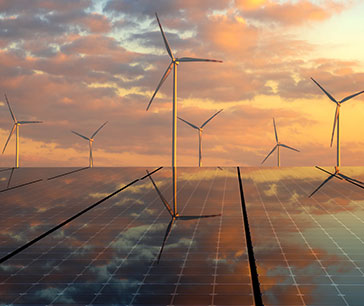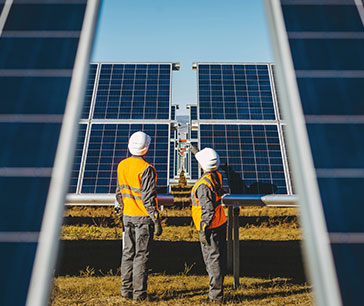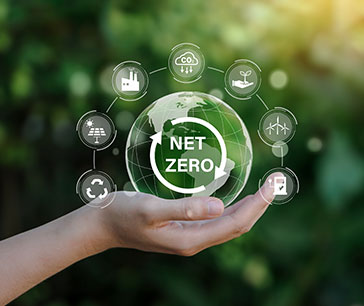Table Of Contents

Yerukola Eswara Prasad

Pooja Parvatkar
Energy & Power Sector 2024 Industry Brief: A Deep Dive into Future Trends, Challenges, Innovations, and Future Lookout

As we step into the year 2024, the energy & power sector stands at a crucial juncture, holding on the key trends and breakthroughs that characterized the industry in 2023. The preceding year witnessed significant shifts in energy consumption patterns, technological breakthroughs, and a rising focus on sustainability. Now, as we enter 2024, it becomes imperative to delve into the challenges faced, innovations spearheaded, trends shaping the industry, and the promising future scope that awaits the energy and power sector. Allied Market Research has drafted an extensive outlook of how the industry is likely to progress in the year 2024.
2023 Recap: A Glimpse into the Past
Renewable Revolution:
The energy landscape in 2023 was marked by a growing emphasis on renewable sources. Noteworthy events such as COP28 in Dubai and Uganda's ambitious net-zero energy plan underscored a global dedication to sustainable practices. Investments in green energy soared, and nations worldwide pledged commitments to reduce carbon footprints.
Energy Storage Prowess:
Advancements in energy storage technology, exemplified by record-setting installations, became a linchpin for ensuring the reliability of renewable sources. Notable breakthroughs, including EnerVenue's Energy Storage Vessels™, showcased the industry's commitment to enhancing storage capabilities.
Smart Grids and Autonomous Systems:

Smart grid infrastructure gained momentum, optimizing energy distribution and elevating grid reliability. The advent of autonomous energy systems, harnessing the power of AI and ML, promised a more efficient, sustainable, and responsive energy future.
Cybersecurity Imperatives:
As digital integration boosted, the industry acknowledged the urgent need for robust cybersecurity measures. From firewalls to intrusion detection systems, energy companies fortified their defenses against evolving cyber risks. For instance, energy companies bolstered cybersecurity protocols with cutting-edge technologies to thwart potential attacks and ensure the resilience of critical infrastructure.
Navigating the Evolving Trends in the Energy & Power Landscape in 2024
The energy & power sector is on the cusp of a dynamic transformation, driven by evolving technologies, environmental imperatives, and shifting global priorities. As we step into 2024, several trends are poised to shape the future of the industry, influencing the trajectory of energy production, consumption, and sustainability. Here are the key trends that will define the industry in the coming year:
Rapid Expansion of Renewable Energy:
The drive toward renewable energy continues to gain momentum, predicting a swift expansion of solar, wind, hydropower, and other sustainable energy sources throughout 2024. Governments, businesses, and consumers are increasingly prioritizing sustainability, driving investments in large-scale renewable projects. The falling costs of renewable technologies, coupled with favorable government policies, will contribute to the widespread adoption of clean energy solutions.
Decentralization and Distributed Energy Resources:
The trend towards decentralization in energy production is gaining traction. In 2024, the rise of distributed energy resources (DERs) such as solar panels, wind turbines, and energy storage systems will empower consumers to generate and manage their electricity. Microgrids and local energy systems will enhance resilience, promote energy independence, and contribute to a more reliable and resilient energy infrastructure.
Electrification of Transportation:
The electrification of transportation is set to accelerate in 2024, driven by advancements in electric vehicle (EV) technologies, supportive policies, and growing environmental awareness. The automotive industry will witness an influx of electric cars, buses, and trucks, supported by an expanding network of charging infrastructure. This trend will not only reduce carbon emissions but also create new opportunities for integrating EVs into the broader energy ecosystem.
Energy Storage Revolution:
Energy storage will undergo a revolutionary phase in 2024, with advancements in battery technologies and other storage solutions. Large-scale battery storage projects will become more prevalent, addressing the intermittent nature of renewable energy sources. Innovations in long-duration storage and grid-scale solutions will contribute to grid stability, supporting the transition to a more reliable and resilient energy grid. It is forecasted that the global market for battery energy storage systems reached $8.4 billion in 2021 and is anticipated to attain $51.7 billion by 2031. Global companies are striving to innovate strategies in the energy storage systems market such as product launches, acquisitions, partnerships, and expansions to gain a strong hold in the industry.
Digitalization and Smart Technologies:
The incorporation of digital technologies, encompassing the Internet of Things (IoT) and artificial intelligence (AI), will continue to play a crucial role in optimizing energy systems. Projections indicate that the global artificial intelligence in renewable energy market is expected to reach $4.6 billion by 2032, signifying rapid growth in the years to come. This growth is primarily attributed to the transformative potential of AI in revolutionizing the renewable energy sector. By optimizing energy production, enhancing operational efficiency, and facilitating intelligent decision-making, the integration of AI technologies like machine learning and predictive analytics is set to advance renewable energy generation, leading the way towards a more sustainable future. Moreover, the deployment of smart grids, smart meters, and intelligent energy management systems will facilitate real-time monitoring, data analytics, and decision-making. This digital transformation is poised to elevate efficiency, minimize energy losses, and pave the way for the development of autonomous energy systems.

Hydrogen Economy Advancements:
The hydrogen economy will witness advancements in 2024, with a focus on green hydrogen produced through electrolysis powered by renewable energy. Hydrogen will emerge as a versatile energy carrier, with applications in sectors such as industry, transportation, and power generation. Collaborative efforts between governments and industries will drive investments in hydrogen infrastructure and research. The hydrogen infrastructure industry is growing amid revolutionary shifts toward net-zero emissions. The global hydrogen infrastructure market is anticipated to reach $13.5 billion by 2032, growing at a CAGR of 10% from 2023 to 2032. Market expansion is driven by heightened investments in hydrogen production, storage, and distribution infrastructure. The establishment of a robust hydrogen infrastructure is crucial to unlocking the full potential of hydrogen as a sustainable energy solution.
Challenges in 2024: Overcoming Hurdles with Solid Strategies
As the energy & power industry gears up for the challenges of 2024, several hurdles loom on the horizon, demanding strategic solutions and collaborative efforts to ensure a sustainable and resilient future. Navigating these challenges will be instrumental in shaping the industry's trajectory in the coming year.
Geopolitical Uncertainties:
One of the foremost challenges facing the energy sector in 2024 is the prevailing geopolitical uncertainties. Tensions and conflicts on the global stage can significantly impact the energy supply chain, influencing resource availability, pricing, and overall energy security. Geopolitical events, such as trade disputes, sanctions, or regional conflicts, can disrupt the smooth functioning of industry. Navigating these uncertainties will require a careful balancing act and proactive measures to mitigate potential risks.
Strategy for Overcoming:
- Diversification of energy sources to reduce dependency on geopolitically sensitive regions.
- Strengthening international collaborations and agreements to ensure stable energy trade.
- Investing in diplomatic efforts to ease geopolitical tensions that could impact the energy sector.
Transitioning from Fossil Fuels:
While there is a global push towards renewable energy sources, the transition from fossil fuels poses a significant challenge. Many regions and industries still heavily rely on fossil fuels for energy production. Balancing the decline in fossil fuel usage with the rapid scaling of renewable projects requires meticulous planning, substantial investments, and a well-thought-out transition strategy. Overcoming the resistance to change within certain sectors and regions is a critical aspect of successfully navigating this challenge.

Strategy for Overcoming:
- Implementing targeted policies and incentives to encourage the shift towards renewable energy.
- Investing in research and development to enhance the efficiency and affordability of renewable technologies.
- Supporting and retraining communities reliant on the fossil fuel industry to ensure a smooth and accurate transition.
Aging Infrastructure:
A significant challenge that persists into 2024 is the aging infrastructure in many parts of the world. Upgrading and modernizing energy infrastructure to accommodate the integration of renewable sources and emerging technologies is crucial. However, this task comes with logistical and financial challenges. Aging grids and facilities may not be equipped to handle the demands of a modern, decentralized energy system. Overcoming this challenge requires substantial investments and a commitment to embracing innovative solutions for infrastructure development.
Strategy for Overcoming:
- Implementing comprehensive infrastructure upgrade programs with a focus on smart grid technologies.
- Encouraging private sector investments through incentives and public-private partnerships.
- Leveraging emerging technologies such as Internet of Things (IoT) for predictive maintenance and real-time monitoring of infrastructure.
Cybersecurity Measures:
In an era where digital technologies are deeply integrated into the energy & power sector, ensuring robust cybersecurity is non-negotiable. The interconnected nature of energy systems makes them vulnerable to cyber threats, ranging from ransomware attacks to espionage. Protecting critical infrastructure from cyber threats requires continuous vigilance, investment in advanced cybersecurity measures, and a commitment to staying ahead of evolving risks.
Strategy for Overcoming:
- Deploying advanced cybersecurity measures such as firewalls, intrusion detection systems, and encryption.
- Conducting regular cybersecurity audits and assessments to identify vulnerabilities.
- Providing continuous training and education for professionals to stay updated on the latest cybersecurity threats and best practices.
Innovations Set to Define 2024: Paving the Path to a Sustainable Energy Future
The year 2024 promises to be a transformative period for the energy and power sector, marked by groundbreaking innovations that are set to redefine the industry landscape. From advancements in renewable technologies to cutting-edge solutions for energy storage and distribution, these innovations hold the key to shaping a more sustainable and efficient future. Here are the key innovations set to define the energy and power sector in 2024:
Next-Generation Solar Technologies:
In 2024, the solar energy sector is poised to witness the emergence of next-generation technologies that enhance efficiency and affordability. Innovations in solar panel designs, such as tandem solar cells and perovskite-silicon tandem structures, are expected to significantly improve energy conversion rates. Additionally, advancements in transparent solar cells integrated into windows and facades will contribute to the seamless integration of solar power into urban infrastructure.
Potential Impact:
- Increased energy output and reduced costs, making solar energy more accessible.
- Greater integration of solar solutions into urban and architectural designs.
Breakthroughs in Energy Storage Systems:
Energy storage is a critical aspect of transitioning to a more sustainable energy landscape. In 2024, innovations in battery technologies are set to take center stage. Lithium-sulfur batteries, solid-state batteries, and flow batteries with longer lifespans and higher energy density are expected to revolutionize the energy storage market. These advancements will address the intermittent nature of renewable sources and support the widespread adoption of electric vehicles.
Potential Impact:
- Enhanced energy storage capabilities for renewable sources.
- Accelerated adoption of electric vehicles with improved battery performance.
Smart Grid Technologies and Artificial Intelligence (AI):
The integration of smart grid technologies and AI-driven solutions will play a pivotal role in optimizing energy distribution and consumption. In 2024, smart grids equipped with advanced sensors, communication networks, and real-time data analytics will enhance grid reliability, reduce energy losses, and seamlessly incorporate renewable resources. AI algorithms will enable autonomous energy systems that continuously monitor and optimize energy production and consumption for greater efficiency.
Potential Impact:
- Improved grid reliability and efficiency.
- Autonomy in energy systems leading to cost savings and reduced inefficiencies.
Hydrogen as a Clean Energy Carrier:
Hydrogen is gaining prominence as a clean energy carrier with diverse applications, from industrial processes to fuel cells for transportation. In 2024, innovations in hydrogen production, storage, and utilization are set to make hydrogen a more viable and scalable solution. Green hydrogen, produced using renewable energy sources, will contribute to decarbonizing sectors that are challenging to electrify directly.
Potential Impact:
- Expanded use of hydrogen as a clean energy alternative.
- Reduction of carbon emissions in hard-to-decarbonize sectors.
Advanced Grid Infrastructure with 5G Connectivity:
The integration of 5G connectivity into energy infrastructure will revolutionize grid management and enable real-time communication between devices. In 2024, the deployment of advanced grid infrastructure with 5G capabilities will facilitate better monitoring, control, and coordination of energy systems. This innovation will pave the way for the efficient integration of decentralized energy sources and enable rapid responses to fluctuations in supply and demand.
Potential Impact:
- Enhanced grid flexibility and responsiveness.
- Facilitation of a more interconnected and dynamic energy ecosystem.
Future Scope and Outlook
Towards Net-Zero:
The trajectory towards achieving net-zero emissions gains momentum. Governments, industries, and consumers are aligning their efforts to transition towards a carbon-neutral future, fostering innovation and collaboration.
Global Collaborations for Energy Security:
In an interconnected world, global collaborations will play a pivotal role in ensuring energy security. Nations are likely to forge partnerships for resource sharing, technology exchange, and collective efforts to address common challenges.
Decentralized Energy Systems:
The future may witness a shift towards decentralized energy systems. Localized energy production, coupled with community-driven initiatives, could redefine the energy landscape, offering resilience in the face of disruptions.
AMR’s Verdict
As the energy and power sector steps into 2024, it is likely to witness a myriad of challenges, embraces innovative solutions, and witnesses the unfolding of transformative trends. The industry's resilience, adaptability, and commitment to sustainability will shape its trajectory, defining a future where clean, reliable, and secure energy takes precedence. In navigating the complexities of the coming year, stakeholders across the globe must collaborate, innovate, and invest in a sustainable energy future. Contact AMR analyst today to gain a comprehensive understanding of industry trends, strategic opportunities, and emerging technologies that can propel your business into a resilient and sustainable future.

